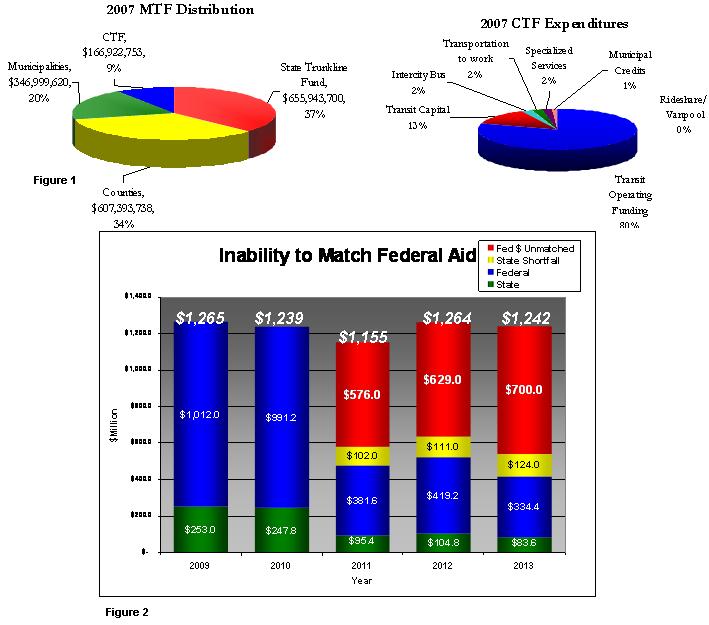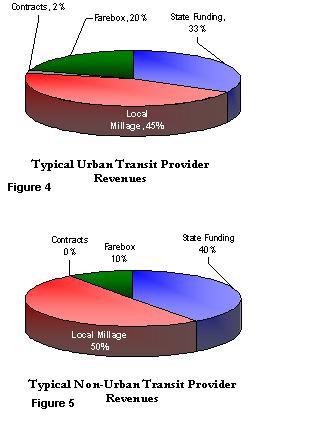Every year, state legislators are charged with the task of balancing the state budget. In a poor economic climate, this can mean budget cuts and trimming services for many state functions. Since 1997, funding for public transit has been cut by almost 30% after inflation, and further cuts are threatening much-needed transportation services that many Michiganders use to get to work, school, doctors, groceries, and other essentials. It is important for Michigan residents to understand how transit is funded and the history leading to this current funding dilemma. When members of the public understand this process, they will be able to make educated decisions and help legislators set priorities.
State Funding for Transportation
Transportation funding comes from several different sources, including taxes on gasoline and automobile registrations. These various sources of transportation funding are fed into a fund called the Michigan Transportation Fund (“MTF”). This fund collected over $1.9 billion in 2008, and was used to fund all transportation-related projects from road construction to transit service. A portion of this fund, called the Comprehensive Transportation Fund (“CTF”) is used for transit operating and capital funding.

1.5% of the CTF, over $10 Million, was diverted to the general fund in 2008. This is not an unusual practice, and has become common place as budgets tighten.
By statute, the CTF can allocate up to 10% of the MTF, meaning the CTF is eligible for over $190 Million. In 2008, the CTF was allocated only 8.5% of the MTF and was nearly $30 Million short of where it could be. This greatly affects capital and operating funding for local transit.
The MTF and CTF are funded mainly through taxes on gas, diesel, and vehicle registrations. Michigan has a 19 cent-per-gallon tax on gasoline, a 15 cent-per-gallon tax on diesel, and a graduated set of registration fees for automobiles.
Right now, some of these transportation-related funds are being redirected from the CTF to the General Fund to pay for other state services. This diversion removed over $10,000,000 in transportation funds out of the CTF in 2008. This is illustrated by the red portion of the transportation funding chart shown above.
Cuts to Funding Hurt Michigan’s Ability to Match Federal Aid
Federal funding must be matched with a state or local contribution in order to be obtained. Most transit projects are funded at 80% of the project cost, meaning Michigan needs only to fund 20% of the project. If we continue to cut funding for transportation, all services will be affected.
As Michigan becomes unable to match federal aid, our overall ability to maintain roads, bridges, buses, and facilities will diminish. In FY 2011, 2012, and 2013, a state shortfall in match funding will contribute to a significant amount of federal money left on the table – nearly $2 billion. A group commissioned by the Governor called the Transportation Funding Task Force (TF2) studied the problem and has proposed several revenue-enhancing and regulatory changes to stop this scenario from happening.

Transit Capital vs. Operating Funding
The distinction between capital and operating funding is very important. Capital funding is used to purchase new equipment. Operating funds are used to pay for expenses that a transit system will incur in providing service. Below are examples of operating and capital expenses.
| Operating | Capital |
| Fuel | Buying Buses |
| Operator Salaries | Buying Other Vehicles |
| Administrative Salaries | Building Construction |
| Maintenance | Building Light Rail and BRT |
| Certain Planning studies |
Transit Capital Funding
When transit providers want to purchase new buses, construct or renovate facilities, or purchase certain technology items, they utilize state match to leverage (or capture) federal funds for purchasing these items. State match is the term for the portion of the total cost that the state provides. Most capital projects are funded with 80% federal and 20% state match. This means a $100 bus is funded with $80 federal and $20 state.

Each dollar of state investment in transit capital yields four dollars of federal investment.
When people talk about Michigan being a ‘donor state’ or losing funding to places such as New York and Dallas, they are likely referencing capital funding. Michiganders pay a national gas tax in addition to their state gas taxes. This national gas tax goes into a fund that pays for many transportation projects nationwide through mechanisms such as the 80% capital match. Without contributing the 20% necessary to capture that 80%, Michigan will continue to lose out on capital funding.
Cuts to capital funding mean Michigan will not be able to leverage as much federal money to keep its infrastructure from becoming dated. As buses and buildings age, they become more expensive to operate, increasing maintenance and operation costs. This hurts efficiency and the quality of services.
Figure 3 illustrates the leveraging ability of state capital funding. In 2009, the state funded $16 Million in state match, leveraging over $80 Million. Every additional dollar of state capital investment brings $4 in federal investment. However, if Michigan does not have enough to match federal funding, this funding is lost.
Transit Operating Funding
Transit systems are funded according to the amount of eligible expenses they incur in a given year. The bulk of these expenses are fuel, wages, and maintenance. Transit systems, such as AATA, CATA, DDOT, JTA, SMART, and The Rapid are all separate, autonomous transit providers that provide service in a designated city or region. There are over 80 transit providers in the state of Michigan.
 The state, by law, is allowed to contribute a significant portion of a transit system’s funding. Urban transit providers are eligible to receive up to 50% of their eligible expenses from state funding. Non-Urban transit providers are eligible for up to 60%. When state funding falls below those thresholds, the same proportion of funding rural operators at 120% of urban providers is held constant (i.e., 40%-48%, 33%-40%, 20%-24%, etc.)
The state, by law, is allowed to contribute a significant portion of a transit system’s funding. Urban transit providers are eligible to receive up to 50% of their eligible expenses from state funding. Non-Urban transit providers are eligible for up to 60%. When state funding falls below those thresholds, the same proportion of funding rural operators at 120% of urban providers is held constant (i.e., 40%-48%, 33%-40%, 20%-24%, etc.)
All transit operations are funded from a mix of the following:
- State funding: (up to 50% for urban transit, up to 60% for non-urban and rural transit)
- Local Funding:
- Millage (property taxes)
- Municipal Budgets
- County Budgets
- Local contracts
- Fare box Revenue
- Miscellaneous federal programs
- JARC/NF
- ADA Service
Although the state has the legal ability to fund transit at 50% and 60%, actual funding levels for 2008 were at 33% and 40%, with the expectation to drop further in the future as state funds dry up. This means transit operators are left with two options: find ways to raise local revenues or cut service.
Figure 6 on the following page shows typical examples of large urban and non-urban budget breakdowns. In reality, transit budgets in Michigan vary from $200,000 in rural areas to more than $150,000,000 in the Detroit area.
| Gotham City Transit | Farmville County Transit | |||
| Eligible Expenses | $ 100,000,000 | $ 5,000,000 | ||
| State Funding | 33% | $ 33,000,000 | 40% | $ 2,000,000 |
| Local Millage | 45% | $ 45,000,000 | 50% | $ 2,500,000 |
| Contracts | 2% | $ 2,000,000 | 0% | $ – |
| Farebox | 20% | $ 20,000,000 | 10% | $ 500,000 |
It is important to note the significant local contribution required by local communities to support transit. Because Michigan does not allow local gas taxes, much of the local revenue comes from local property tax millages. A property tax millage taxes all types of property, including residential, commercial, and industrial uses.
Other states around the nation have multiple streams of funding for transit service. In Chicago, for instance, there is an additional regional gas tax and a tax on hotels that helps fund their transit service. Governor Granholm’s Transportation Funding Task Force (TF2) explored different ways of funding transportation and transit sustainably in the future. Information on this group and their recommendations is available at: http://tinyurl.com/yp7gex.